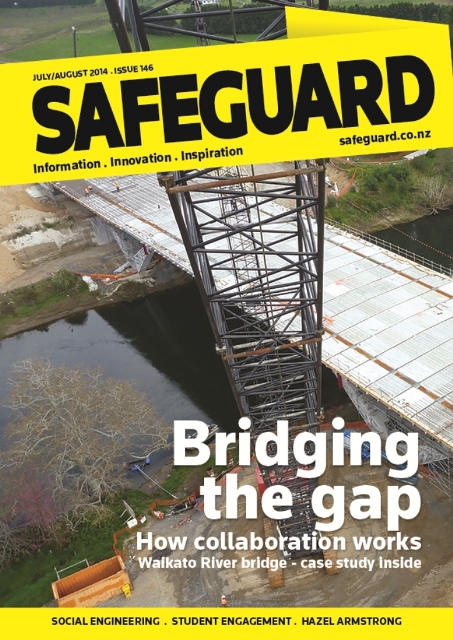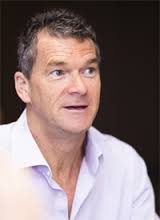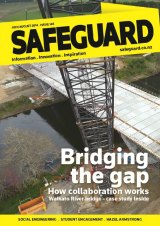Social engineering
 A change in the law won’t be enough on its own to shift New Zealanders’ attitudes to health and safety. PETER BATEMAN Editor of Safeguard OSH Solutions asked the man behind many of WorkSafeVictoria’s most effective campaigns for some tips.
A change in the law won’t be enough on its own to shift New Zealanders’ attitudes to health and safety. PETER BATEMAN Editor of Safeguard OSH Solutions asked the man behind many of WorkSafeVictoria’s most effective campaigns for some tips.
Peter says:
I’m prepared to go out on a limb here and say that the Government is unlikely to meet its key health and safety target without investing in an effective, long-term social marketing campaign to change New Zealanders’ attitude to workplace risk.
That goal, of course, is to reduce workplace fatalities and serious harm injuries by 25 percent by 2020. It’s an ambitious target and one that will require a raft of new initiatives.
We already have a new Crown agency dedicated to workplace health and safety, and next year we will replace our key health and safety legislation with an entirely new statute – with a swag of new Australian-inspired supporting regulations already being drafted. The new legislation will impose explicit duties on company directors and senior executives and backs them up with much higher potential penalties than we have been used to.
But will all this activity be enough to achieve the goal? I have my doubts, unless we also tackle the underlying issue, which is that most New Zealanders don’t take health and safety particularly seriously. It’s just not on our radar, or if it is, it’s too easy to dismiss as a bunch of compliance red tape which just stops us getting things done.
CONSENSUS VIEW
The April 2013 report of the Independent Taskforce reached similar conclusions. Its model of New Zealand’s overarching health and safety system regarded the social-cultural environment as one of four components of the system, including the “impact of New Zealand culture (values, attitudes and perceptions)”.
On paragraph 139 of the report the Taskforce writes:
New Zealand’s national culture includes a high level of tolerance for risk, and negative perceptions of health and safety. There appear to be a number of prevailing values and norms that are at odds with a safety-conscious, harm-preventive and compliance-based workplace health and safety system.
A little further on, paragraph 143 says:
New Zealand’s culture is widely seen as a key contributor to New Zealand’s poor health and safety performance. A number of features of our psyche and cultural landscape were identified by people who made submissions to the Taskforce.
The report went on to list these features as:
- Complacency (our laid back attitude);
- Passivity (we think others are responsible);
- Haste before care (we will take shortcuts or adapt inappropriate equipment to get the job done);
- Distaste for red tape (we are resistant to regulations);
- Tall poppy (we are reluctant to ask questions for fear of appearing stupid);
- Stoic (we don’t want to be told we need to harden up).
VICTORIA’S SECRET
So we have a problem, but we don’t have to look very far for some possible solutions. For more than a decade WorkSafe Victoria – recently rebranded as the Victorian WorkCover Authority – has set the pace with some effective social marketing campaigns which have put health and safety squarely on the public agenda and got people talking. Research indicates they have a high recall rate. Probably not coincidentally, Victoria’s rate of work-related fatality and serious injury is the lowest in Australia, and considerably lower than ours.
[caption id="attachment_6526" align="alignright" width="160"] Ian Forsythe[/caption]
Ian Forsythe[/caption]
To learn more I visited the Melbourne office of Ian Forsyth, managing partner of behaviour change consultancy The Shannon Company, who until 2013 spent eight years in senior roles at WorkSafe Victoria and was heavily involved in its campaigns. (A case of gamekeeper turned poacher?)
“The most important reason for workplace safety is not about the workplace at all,” he explains. “Take it out of the workplace and focus on family and children – that’s where you get the leverage.”
In other words, an effective campaign asks each of us to reflect on what we would miss out on if we were seriously injured at work.
Back in 2006, he recalls, there was a need to reposition the Victorian regulator both externally and internally. The result was the Homecoming campaign, which he describes as a game-changer.
“It was as important internally as externally. It built pride in how we felt about ourselves as a regulator, it meant people had pride wearing the uniform when they went into workplaces.”
This campaign, and the many that followed (see two examples on these pages), were designed to underpin the work of inspectors by giving them more leverage, given that it is impossible for inspectors to visit every workplace every twelve months. Strategically, the campaigns sent the message that health and safety is important; tactically, they sowed doubt in the minds of business owners: will the regulator visit my workplace? “It’s leveraging the physical presence by making the organisation appear bigger than it really is.”
Strategy and tactics: the first is the role of the broad, positioning campaigns which seek to make a strong emotional connection, while the tactical campaigns focus tightly on depicting inspectors in the workplace dealing with the issues of the day: manual handling, falls from height, young workers and so on.
“It’s a dual approach. You take the moral high ground and say it is antisocial not to have a safe workplace, plus a tactical approach on particularly risky activities. It’s got to be: that could be me!”
CAMPAIGN MEASUREMENT
Forsyth says there are a number of ways to measure the impact of a campaign, including research which asks:
- Have you seen the campaign?
- What was the campaign’s take-out message?
- What have you done about it?
- Has it prompted you to take action in your workplace?
Last year The Shannon Company and Sweeney Research worked together to interview more than 2500 Australians to try to get a handle on what Australians are worried about, on a broad range of social topics covering health, road safety, work safety, discrimination, gambling, domestic issues, and community safety.
Published under the title Australia’s Behaviour Concerns, Forsyth says the results showed than in Victoria there is a higher level of concern about workplace health and safety compared to other states, and a much higher awareness of health and safety campaigns. “Therefore,” he concludes, “people are more aware, therefore more concerned, therefore we get safer outcomes.”
It is hard to argue with the data, which shows a consistent improvement in Victoria’s rate of workplace serious injuries and fatalities. “They’ve been falling year on year, consistently. Victorian workplaces are the safest in the country.”
Forsyth certainly doesn’t claim full credit for this outcome for the social marketing campaigns – he’s far too sophisticated for that. To be effective, he says, campaigns must align with getting the regulator’s message across, and with the regulator’s position on inspections and enforcement. He recalls that in the 1990s Monash University’s Accident Research Centre looked at the reasons behind Victoria’s falling road toll, and credited 30% to the police’s use of booze buses, 30% to the introduction of speed cameras, and 30% to public awareness campaigns. The conclusion? All three together were required.
CLUTTERED MESSAGES
Having a socially worthwhile message to get across isn’t enough, he warns. Both Australia and New Zealand are cluttered with marketing messages from public and private sectors. “You can’t rely on the inherent goodness of your message. Everyone is competing for people’s head space. Don’t assume that because it is a public good that people will take it on board.”
The key, he says, is that each campaign should tell a distinct emotional story – just showing people what they should do won’t cut it. “You need that emotional engagement because that leads to behaviour change. I think that’s what we’ve seen in Victoria.”
Another point, he says, is to keep the story out there. “Don’t expect to run a campaign for a couple of months and change the world. Why does McDonald’s advertise? After all, people know where their stores are. So you need constant presence to build the brand and the engagement.”
Naturally, having moved to the private sector to work for a social marketing firm, Forsyth is a proponent of the social marketing approach. But he’s a true believer from his time at WorkSafe Victoria, and before that at the Transport Accident Commission. He would love to see New Zealand make a serious attempt at using social marketing in the workplace safety space. But it’s not going to be cheap. It needs serious stakeholder engagement and strong qualitative research to formulate a campaign, and serious funding to see it through.
“You need to resource this thing fully for people to see it. But in the overall strategy of encouraging safer workplaces the public awareness campaigns are a very important component. If you are not going down that path, you are missing a very big opportunity.”
FUTURE PROSPECTS
WorkSafe New Zealand seems to have got the message. In an April 28 press release for Workers’ Memorial Day, chief executive Gordon MacDonald acknowledged the creation of a dedicated OHS agency, and the imminent arrival of new health and safety legislation. But these two measures, he warned, while critical, will not be enough on their own to meet the Government’s reduction target by 2020 without a culture change in how health and safety is viewed.
“To get some perspective on culture change and the difficulties in making it happen,” he wrote, “you need only look at the campaigns run by the New Zealand Transport Agency on drink driving and wider road safety. Millions of dollars have been spent each year over more than a decade to achieve the advances we’ve seen. Much the same can be said of the stop smoking campaign. They’ve achieved success and considerable social and economic good has flowed from their success.”
He goes on to write: “We can do the same for health and safety in the workplace. But we don’t have a decade to reach our targets,” going on to call for all of us to pull together to get the result.
So – not exactly a promise of major social marketing campaigns to come, but a fair hint that the prospect is on the radar.
If Victoria is any guide, it can’t start soon enough.
 Find out more
Find out more
This article is one of several free to browse on the new Safeguard OSH Solutions website.
Now everything Occupational Health and Safety is conveniently located in one hub: the magazine, other publications and resources, information about events, suppliers, jobs ...
To find out more please visit: Safeguard OSH Solutions